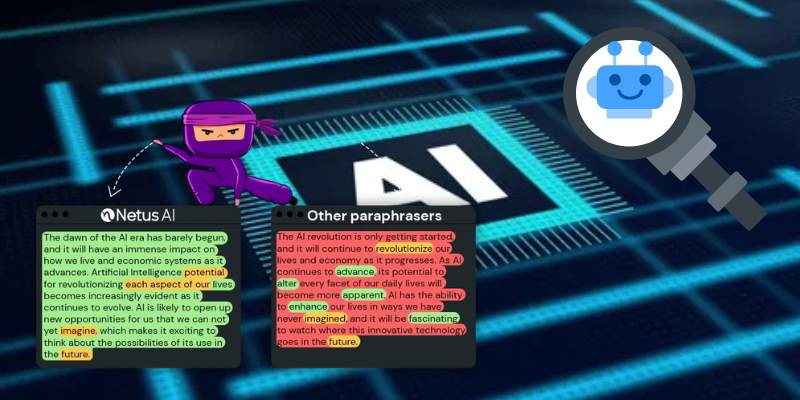Deadlines don’t care whether inspiration showed up. You’ve got a passable AI draft, a blinking cursor, and a tiny voice asking, “Will this read like me?” The goal isn’t trickery; it’s ownership—clear claims, honest evidence, and a voice that takes a stand.
A quick dialogue—the kind that actually fixes drafts
“Does this sound like me?”
“Almost. What’s the one claim you’d defend in a room full of skeptics?”
“That AI helps me start, but learning lives in revision.”
“Great—there’s the spine. Keep it. Now add stakes, bring a counterpoint, and show receipts.”
Questions, feedback, solutions. That rhythm—not secret phrases—turns a bland draft into credible prose.
My stance in one breath
Fluency isn’t thinking. I’ll take a lumpy paragraph with a sharp, defensible idea over a silky paragraph saying nothing. Passing human and AI detection follows naturally when you prioritize reasoning, evidence, and accountable voice.
What gets flagged (and bores readers)
- Samey cadence. Machine-y prose often hums at one tempo. Humans mix it up: jab, breath, pivot.
- Confident, source-light claims. Sounds sure. Says little.
- Safe-but-empty transitions. “Additionally… furthermore…” on loop.
- Shaky citations. If a claim matters, it must trace to something real.
We counter those with varied rhythm, lived specifics, and verifiable substance.
A nonlinear rewrite workflow that actually works
I don’t begin at the beginning. I hunt for heat.
- Write the takeaway first. If the last paragraph is bland, the piece is hollow. Fix the end; the middle finds its job.
- Discover the thesis, then say it once—crisply. One sentence, specific enough to be wrong.
- Map the argument: Problem → Stakes → Claim → Evidence → Counterargument → Implications → Close.
- Backfill with lived texture. Details only you could know: the Tuesday retro, the professor’s red pen, the 7:42 jeep that’s always late.
- Cut lines that don’t work. Pretty sentences with no job? Gone.
If you want help tidying grammar while keeping intent, reach for an AI Text Humanizer that Overcomes Copyscape Checker—a coach, not a crutch.
The thinking-first loop (use this verbatim)
Ask: What question is the reader actually trying to answer?
Feedback: Two ideas are wrestling; neither is winning.
Solution: Promote one governing question to the headline and the first two paragraphs.
Ask: Where would a skeptic land a clean punch?
Feedback: Paragraph four sounds sure but has no receipts.
Solution: Add a credible source, summarize the strongest counterpoint, then meet it directly.
Ask: Which sentences are “style over signal”?
Feedback: Three metaphors, zero numbers.
Solution: Trade one flourish for a stat or a checkable example.
When you’re a student balancing clarity with originality, build a AI Text Humanizer that is Undetectable workflow: read deeply, reason out loud, draft with assistance, then revise into your own argument—with transparent citation.
Voice: sounding like a person (you) instead of a blender
- Vary rhythm on purpose. Short. Then longer, with nuance. Then a pivot.
- Keep a voice bank. Lines you actually wrote—verbs you overuse, jokes you’d tell, turns you love. Sprinkle lightly.
- Admit limits. “Here’s where I might be wrong.” Readers trust that more than overconfident mush.
- Use concrete, falsifiable examples. “Three interviews said X,” not “People say…”
For long drafts and iterative editing, a AI Text Humanizers Without Word Limit scales better than any shortcut: outline, draft, test, revise, cite, reflect.
Before/after (tiny but telling)
Serviceable AI-ish draft:
“Remote internships broaden access but challenge mentorship and community. Companies should adopt best practices to sustain engagement.”
Rewritten with spine and stakes:
“Remote internships widened the door—and quietly moved mentors down the hall. Access is real; so is the day-three silence when Slack goes still. Skip forced socials. Add two low-stakes rituals: a daily ‘unmute window’ for naïve questions and a rotating ‘shadow slot’ where interns watch real decisions. Access without apprenticeship isn’t opportunity; it’s a screenshot.”
Specific stakes, defendable fix, lived texture.
Common traps (and exits)
- Rephrasing without re-thinking.
Exit: Write a one-sentence “because.” If you can’t, you don’t have a claim yet. - Over-humanizing with quirks.
Exit: Cut two flourishes; add one number and one named source. - Summary stacks.
Exit: After every summary, add your judgment: what’s strong, what’s weak, what you conclude.
Evidence that holds up
- Prefer primary sources to tertiary summaries.
- Quote precisely; link directly; include page or section when relevant.
- After each citation, add: So what changes because of this?
- Keep an edit trail. It proves authorship and improves your craft.
A pocket checklist for the final pass
- Claim in one breath, specific enough to be wrong.
- At least one credible counterargument, fairly stated and addressed.
- One paragraph that scares you a little (because it names real stakes).
- Facts trace to reliable sources; quotes are accurate.
- Sentences vary in length and structure; transitions earn their keep.
- Closing paragraph tells the reader what changes now.
Quick Q&A
Q: How do I keep the draft sounding like me?
A: Write one paragraph cold—no assistance—then harmonize the rest of the draft to that cadence.
Q: What if the AI’s take is wrong but reads smoothly?
A: Replace fluency with evidence: one statistic, one primary source, one story you witnessed.
Q: How do I avoid samey rhythm?
A: Read aloud and break where you naturally pause. Combine elsewhere. Let your breath line-edit your prose.
Bottom line
Don’t optimize for invisibility. Optimize for significance. When your prose shows how you reasoned—claim, evidence, counterpoint, implication—it reads as human because it is. Detectors fade into the background. The reader stays.

